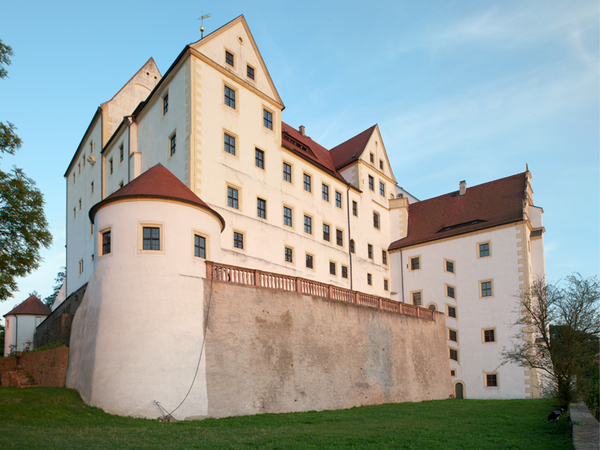The Castle in the Middle Ages
Colditz Castle was mentioned for the first time in 1046 in a marriage certificate, together with the castles in Rochlitz and Leisnig. King Henry III. donated the estates of his wife Agnes of Poitou. Their son donated the castle to Wiprecht of Groitzsch. After it returned to the German royal family, it is given to a commissionaire. From this line of dignity, an extensive rule of the Lords of Colditz developed. It was not until 1404 that the Lords of Colditz had to cede their estate to the Wettins. In 1430 the Hussites destroyed the city and the castle. Little is known about the reconstruction at the castle.
Hunter's Castle and Widow's Residence
Electress Margarethe of Austria is given Colditz as a jointure. She is the wife of Frederick the Gentle. After the death of her husband in 1464, however, she prefers to stay in Altenburg Castle. Elector Ernst continues the construction and uses Colditz Castle for hunting stays. Fortunately, when the bakery servant Clemens Bock burned down the city and the castle in 1504, the castle building was only partially destroyed. From 1506, Frederick the Wise rebuilt the castle in Renaissance styles. New royal dwellings are built. Lucas Cranach Senior provides them with paintings and designs and chooses parts of the interior. From 1520, Frederick stays in his new castle almost as often and as long as he does in his - now no longer existing - favourite castle in Lochau. He remains until his death in 1525. The most important Colditz widow moves into the castle around 1603. Sophia of Brandenburg was formerly the wife of Elector Christian I.. She resides at Colditz until 1622 and gives the residence its final heyday. The gardens now almost completely surround the castle. They are connected with each other by stairs, grottos, terraces, pleasure houses, ponds, vineyards and fountains and are ornately decorated.
Workhouse and Lunatic Asylum

Towards the end of the 18th Century, Colditz Castle becomes a country workhouse for beggars and tramps. About 200 men and women work in the tailor shop and in spinning rooms and make up the building’s own housekeeping and gardening staff. Disabled and mentally ill people are also among them. In 1829 the castle becomes the »State Institute for the Incurable Mentally Ill«. Their first director Christian August Fürchtegott Hayner enforces the concept of treatment of the insane without shackles and chains, which is still in its infancy in Europe at this time. For the first time, he also hires nursing staff and does not have the mentally ill cared for by inmates. The institution remains in Colditz up until 1928.
Early Concentration Camp and Euthanasia
From March 1933 to August 1934, the new political regime of Germany imprisons anti-fascists and communists at the castle. The general ledger lists 2,311 people who suffer from severe isolation, flogging and torture. The most famous inmates include the former Saxon Interior Minister Hermann Liebmann and the writer Bruno Apitz.
In January 1938, the castle is a »health and nursing home« once again. However, patients from all over Saxony are housed and isolated, who were bothersome to other institutions due to their high care expenses. Colditz becomes a crime scene of the early euthanasia murders of »hereditary and mental patients«. Their daily calorie intake was reduced with a »special diet« to such an extent that patients are killed in a cruel manner. By starving for several months, 84 people die in the castle. Since 2017 there has been a special memorial site dedicated to them in the hall basement.
Oflag IV C
The Oflag IV C prisoner of war camp was established in October 1939. The armed forces manage it until the end of the war according to the rules of the Geneva Convention. Polish officers are the first prisoners. They are followed by British, French, Dutch, Belgians and Yugoslavs. From 1940, such officers are only in Colditz, who often break out of other camps. Even those who are particularly hostile towards the Germans or are prominent persons, come to Colditz. Their fame as »bad boys« is gained by daring escape attempts. These are considered legends of military history. The popular reception started in 1952 with the book »The Colditz Story« by Pat Reid. This still attracts a wealth of books, films and documentaries. Tens of thousands of visitors come annually to see the scene of the action at Colditz.
Opening hours and admission prices
Museum Schloss Colditz
now open 10:00 - 18:00
- Monday
- 10:00 bis 17:00
- Tuesday
- 10:00 bis 17:00
- Wednesday
- 10:00 bis 17:00
- Thursday
- 10:00 bis 17:00
- Friday
- 10:00 bis 17:00
- Saturday
- 10:00 bis 18:00
- Sunday
- 10:00 bis 18:00
- Full rate :
- 10,00 EUR
- Reduced rate :i
- 8,00 EUR
Further information on opening hours and admission prices can be found here








